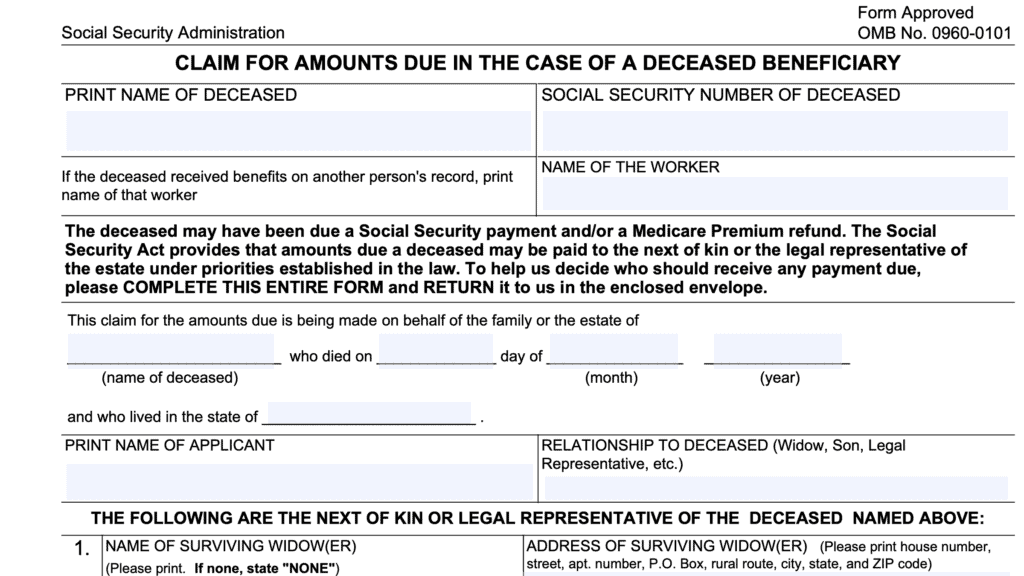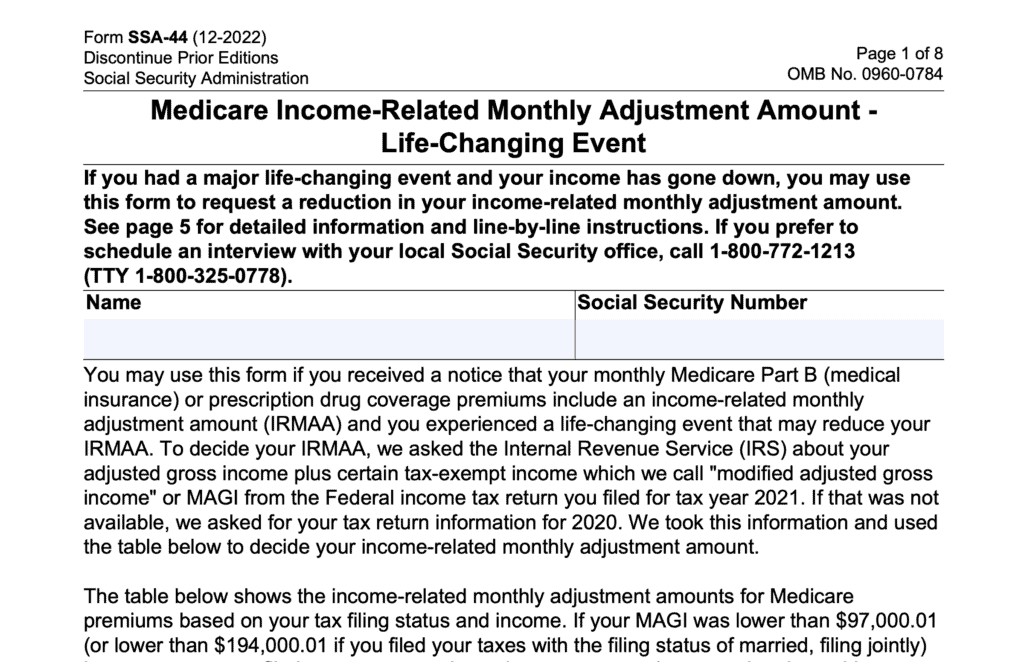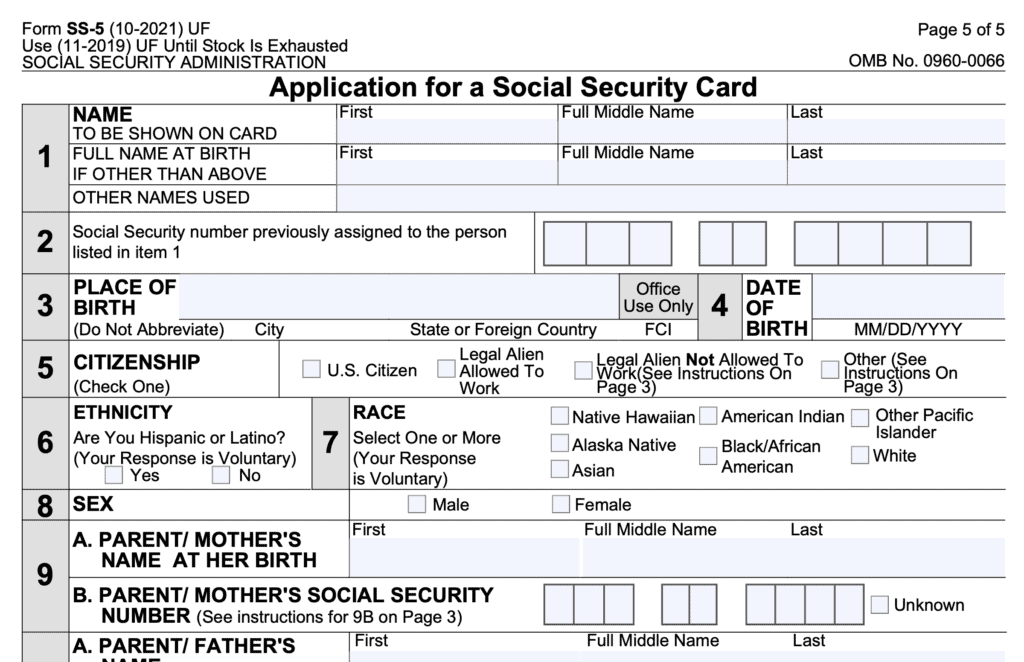Form SSA 3368: A Guide to Your Disability Report
If you’re applying for disability benefits from the Social Security Administration, you may be trying to complete SSA Form 3368-BK, Disability Report. Although you should receive professional advice from a disability attorney or advocate, this might not be an option for every situation.
This in-depth article will walk you through each step of the SSA Form 3368 so you can start receiving Social Security disability benefits.
Table of contents
- How to fill out Form 3368-BK
- SSA definition of disability
- Privacy Act Information
- Paperwork Reduction Act Information
- Section 1: Information About the Disabled Person
- Section 2: Contacts
- Section 3: Medical Conditions
- Section 4: Work Activity
- Section 5: Education and Training
- Section 6: Job History
- Section 7: Medicines
- Section 8: Medical Treatment
- Section 9: Other Medical Information
- Section 10: Vocational Rehabilitation, Employment, or Other Support Services
- Section 11: Remarks
- Why should I seek professional assistance?
- Video walkthrough
- Frequently asked questions
- Where can I find Form SSA-3368-BK?
- Related articles
- What do you think?
How to fill out Form 3368-BK
The form’s instructions are fairly straightforward. However, there are some things worth pointing out before starting the form.
Use the correct version of Form 3368
If you google “SSA Form 3368,” you might find two versions of the same form.
The top result, also known as a ‘featured snippet,’ is will probably catch your eye first. So you might be tempted to download it. But before you do, check to see which version of the Form 3368 this is.
In the below screenshot, clicking the top link sends you to a version of the form dated 10-2015. This is an obsolete version of the form.
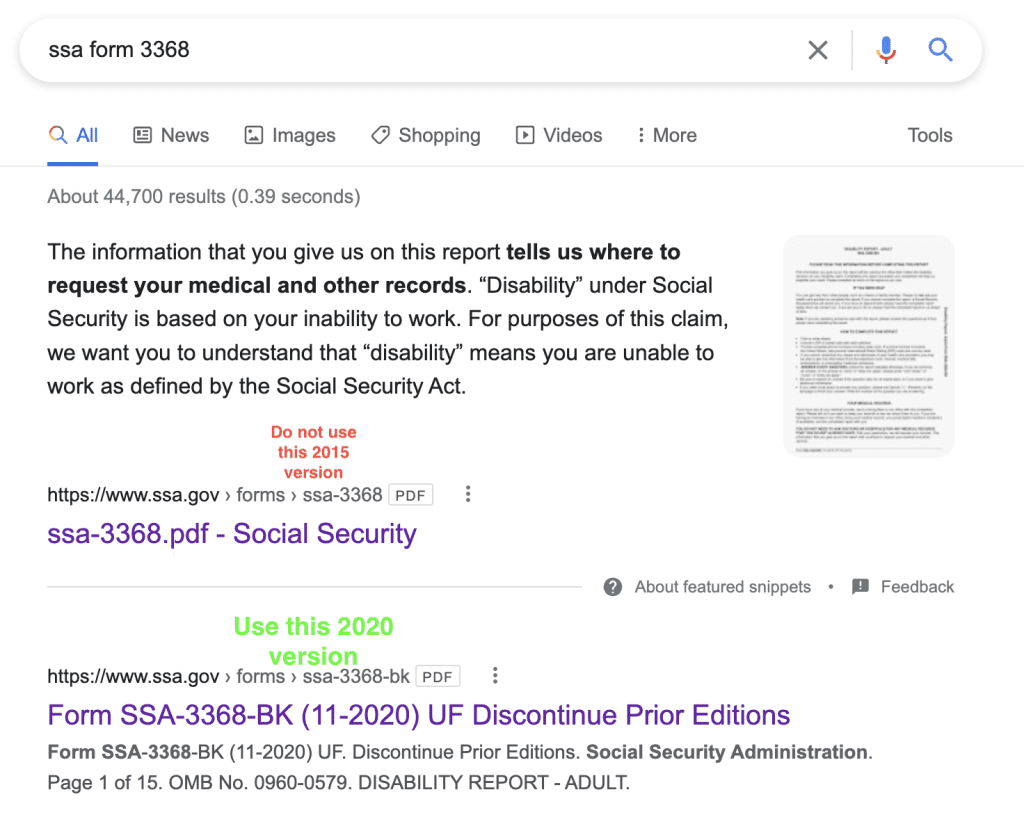
Instead, you’ll want to use the version from 11/2020. In this case, it was the second search result.
Your search results might vary–just make sure you download the most updated version of the file. In this case, that’s the version containing Form SSA-3368-BK.
Another way to tell the difference between the forms is where the form marker is. On the correct form, you’ll see “Form SSA-3368-BK” in the top left corner of each page, while the incorrect version has the form information on the lower left-hand side.
Additional guidance
Here are some additional tips from the form instructions.
- Print or write clearly.
- Provide complete information.
- Answer all questions, unless indicated otherwise.
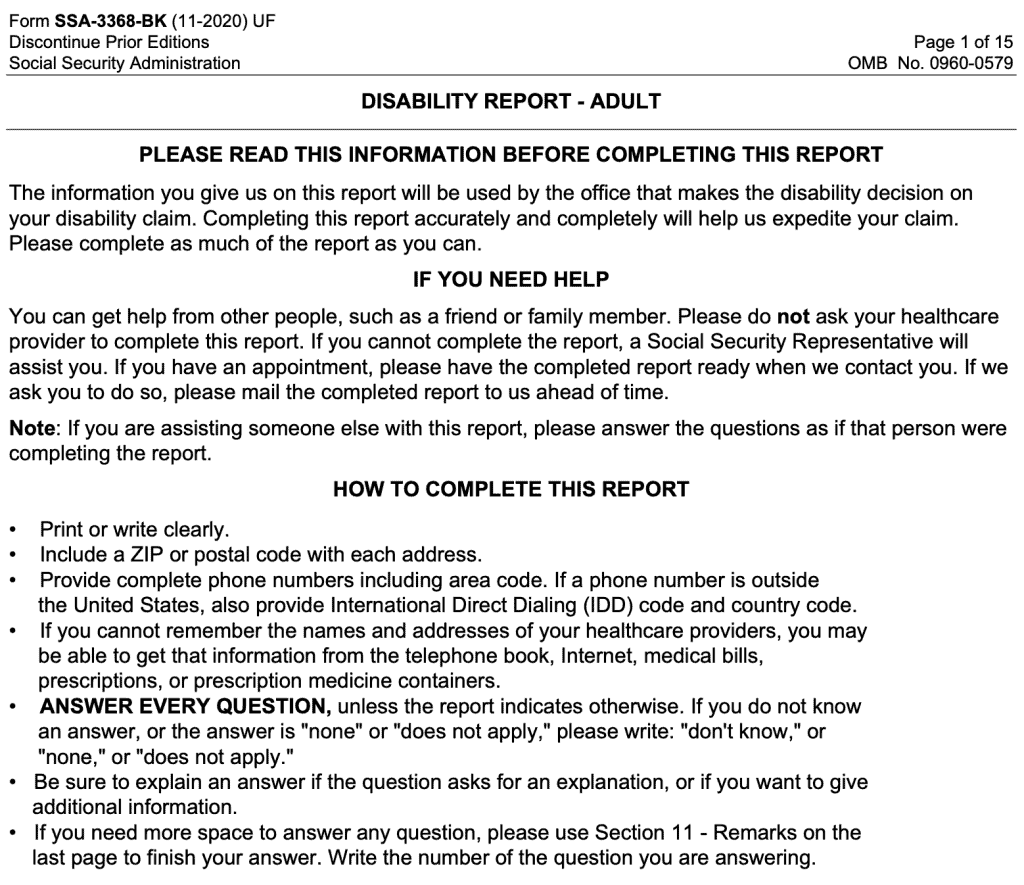
Your goal should be to help the SSA approve this on the initial determination without having to file a disability appeal or request a formal conference. Part of that means ensuring that a human user can actually:
- Read what you’re putting into the information fields
- They have complete information to make a fully informed decision about your stated disability
SSA definition of disability
This section is to let you know that for purposes of Social Security benefits, the Social Security Act defines the term “disability.”

It’s important to note that the SSA considers you disabled if you are unable to do any work on a sustained basis due to your disability, but at a minimum:
- At least 1 year, OR
- Your disability is expected to result in death
Privacy Act Information
According to the Privacy Act, you are not required to provide any information about your health conditions or medical records to the federal government. However, the Social Security Administration can share any information that you do provide with relevant parties and organizations either:
- In the efficient administration of government programs
- To the extent necessary to process your claims
Paperwork Reduction Act Information
In accordance with the Paperwork Reduction Act, the federal government estimates that it might take about 90 minutes for the average person to gather facts, read instructions, and complete this form.
Section 1: Information About the Disabled Person
In Section 1, you’ll complete the information fields about the disabled person. If you are completing this form on a disabled person’s behalf (for a friend or family member), answer the questions as if you are the disabled person.
Again, it’s important to complete all fields, and to print all answers so another person can read them.
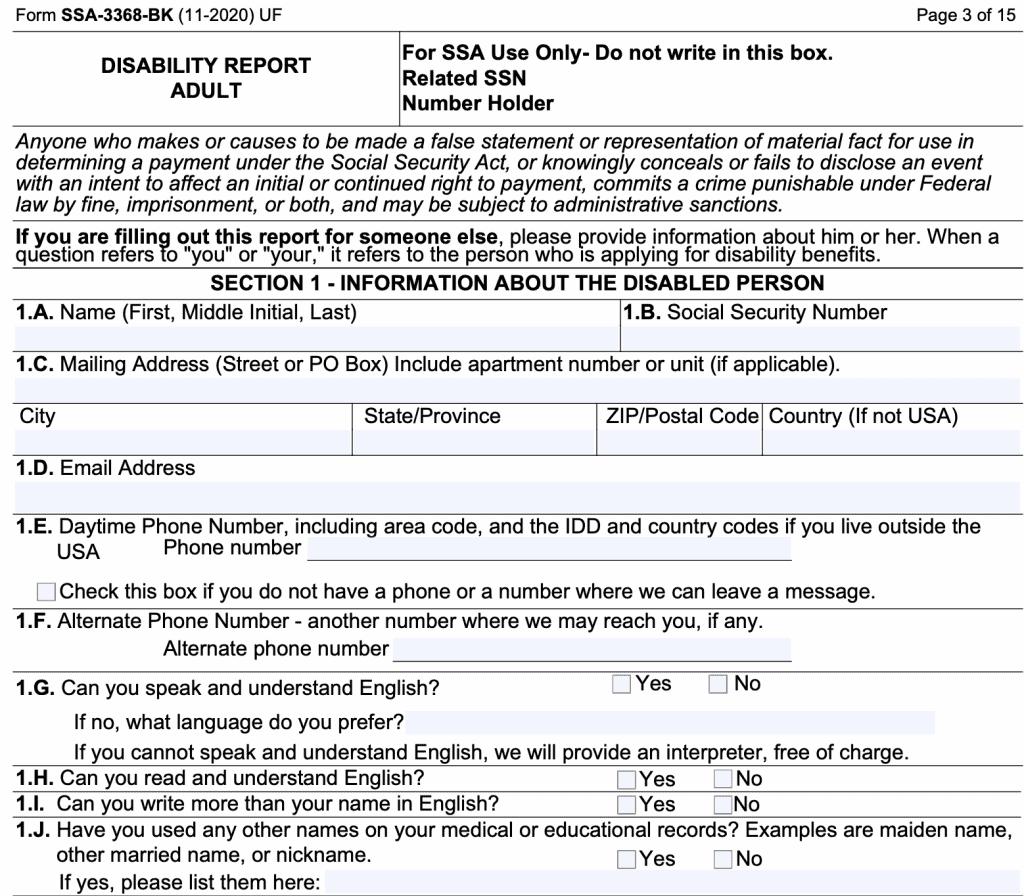
Section 2: Contacts
In Section 2, you’ll provide the contact information of another person who can talk with the SSA about your medical condition. However, it cannot be your primary care physician or any health care professional who is treating you.
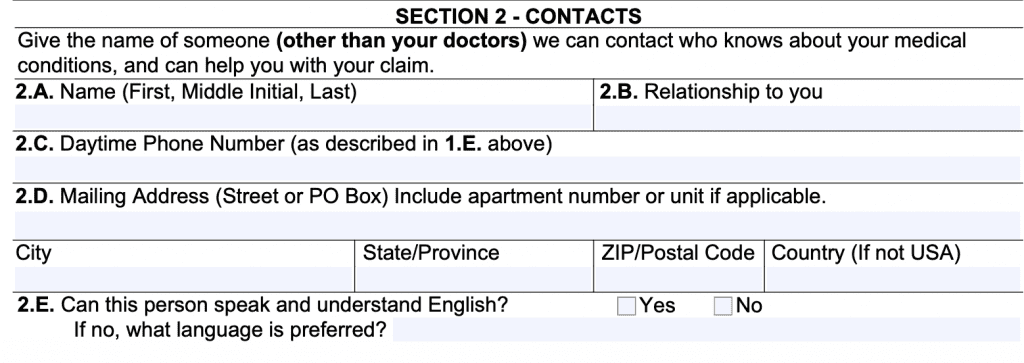
Section 3: Medical Conditions
In the following section, you’ll simply cite the physical or mental conditions you think would prevent you from substantial gainful activity. This might include:
- Conditions with a long-term impact to a body function, especially if it directly affects your functional abilities on the job
- Mental impairment
- Emotional problems
You should note that you’ll be asked to provide medical records to support your stated medical conditions.
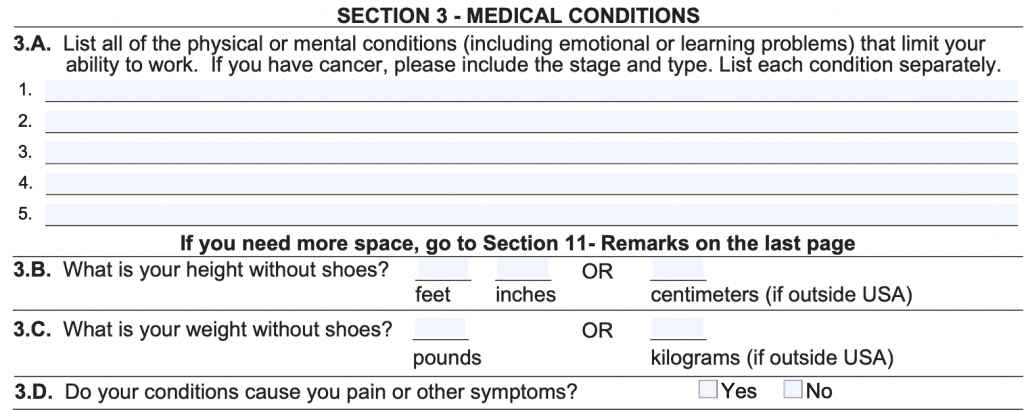
Section 4: Work Activity
In the Work Activity section, you’ll fill in information about your work history. Depending on how you answer 4.A, you’ll skip to the appropriate section to explain either:
- When your condition(s) became severe enough to prevent you from working
- Why you had to stop or reduce your work
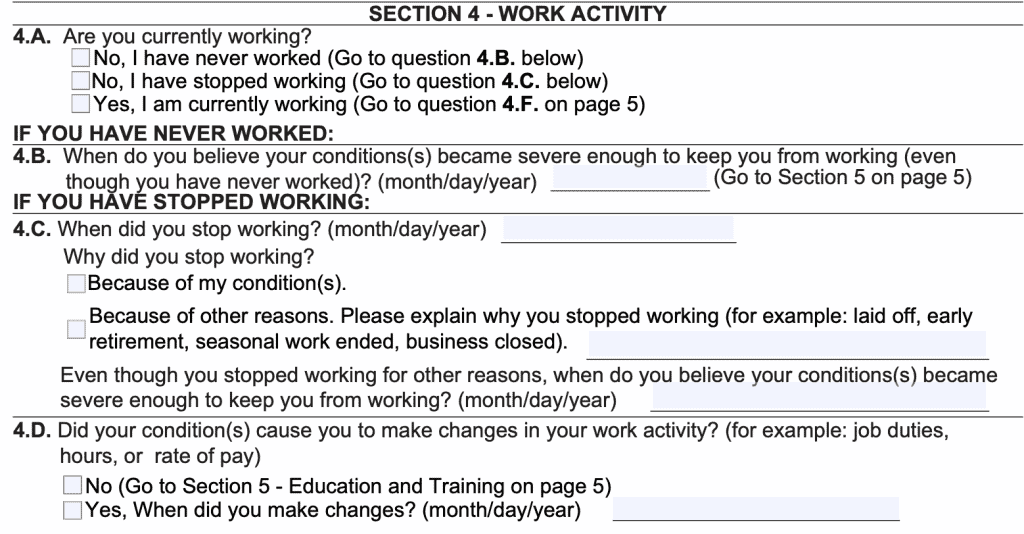
Section 5: Education and Training
Under education and training, you’ll fill out the sections to include:
- Highest level of completed education
- Whether you attended vocational school or specialized training
- What language you use in your daily life
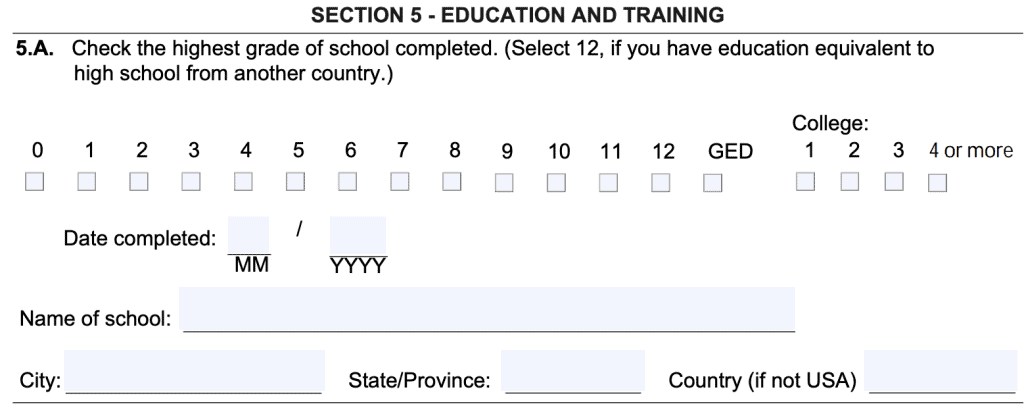
Section 6: Job History
For your job history, you’ll list up to 5 jobs that you’ve had over the past 15 years before you became unable to work. List all past relevant work.
If you only had one job: You’ll need to complete 6.B through 6.I.
If you had more than 1 job: Check the appropriate box in 6.A. and move on to Section 7.
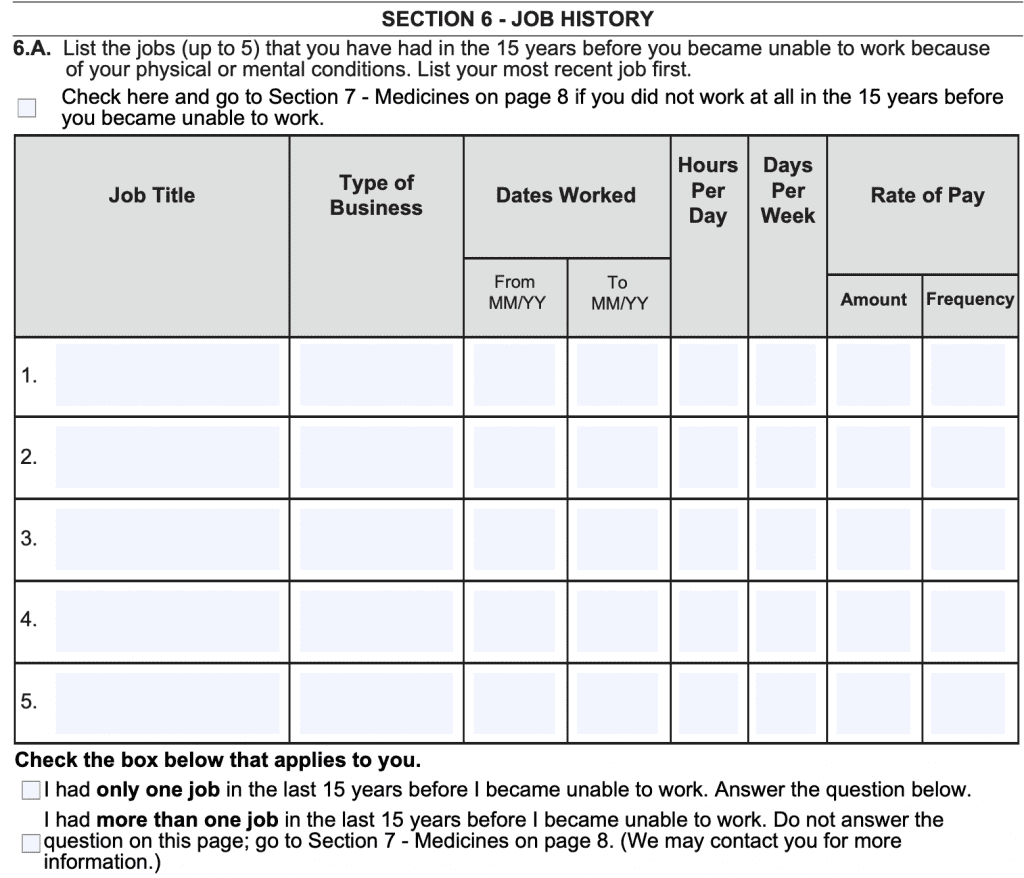
Section 7: Medicines
In this section, you’ll simply list all medicines you’re taking, the reason you’re taking them, and the doctor who prescribed them, if applicable.
If your list of medications exceeds the number of lines in Section 7, you can continue in Section 11-Remarks.
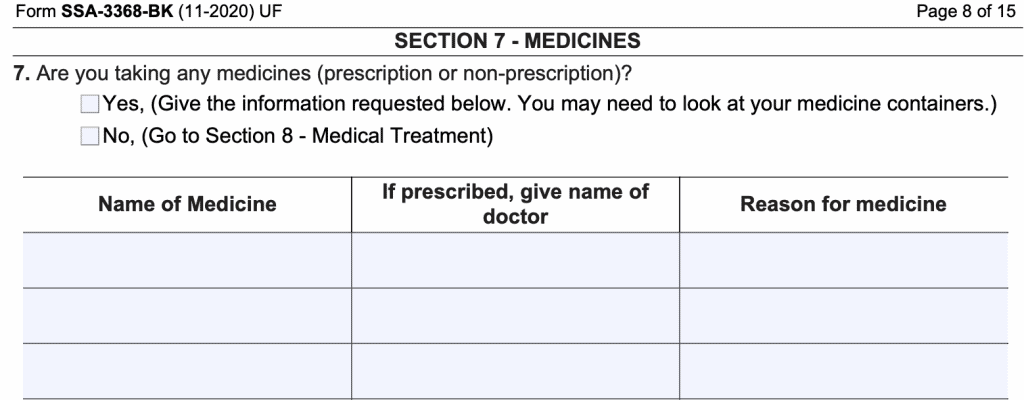
Section 8: Medical Treatment
Section 8 is probably the longest section. You’ll list your history of medical treatment here, by treatment facility.
For each health care professional or hospital visit, you’ll be asked:
- Provider’s name
- Dates of treatment
- Medical conditions treated or evaluated
- Treatment provided
- Tests administered
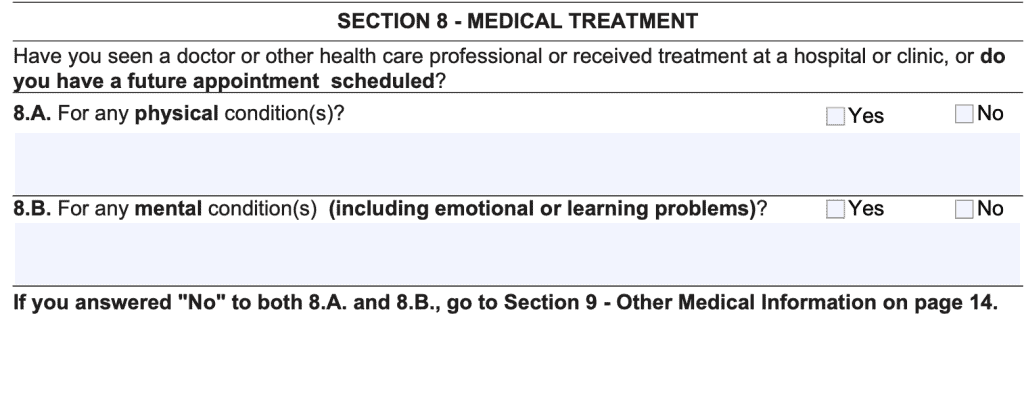
Section 9: Other Medical Information
In Section 9, you’ll list medical information about your condition(s) that someone else might have, other than your health care provider.
This might be the case if you’ve ever:
- Applied for worker’s compensation
- Participated in vocational rehabilitation
- Filed for disability benefits from an insurance company or another government agency
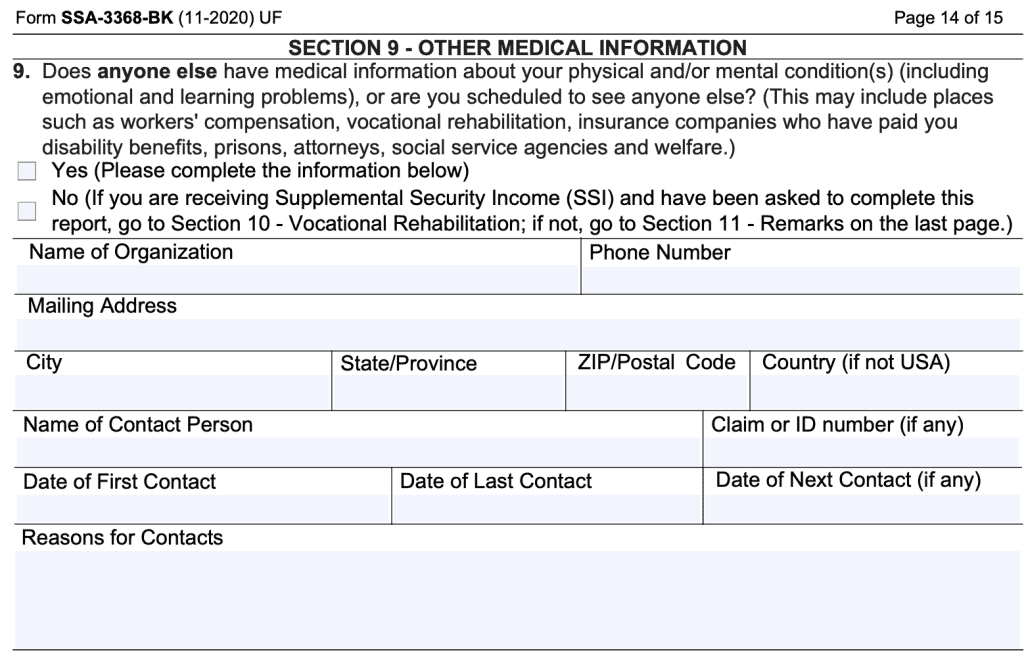
Section 10: Vocational Rehabilitation, Employment, or Other Support Services
You only need to complete this section if you are receiving SSI benefits. SSI benefits are also known as Supplemental Security income, and is paid to certain qualifying low-income recipients to help provide basic necessities.
If you’re receiving SSI payments, you’ll answer whether you’ve worked with anyone on an individual work plan. Or if you’re a full-time student, an Individualized Education Program (IEP) through your school or any other vocational rehabilitation services.
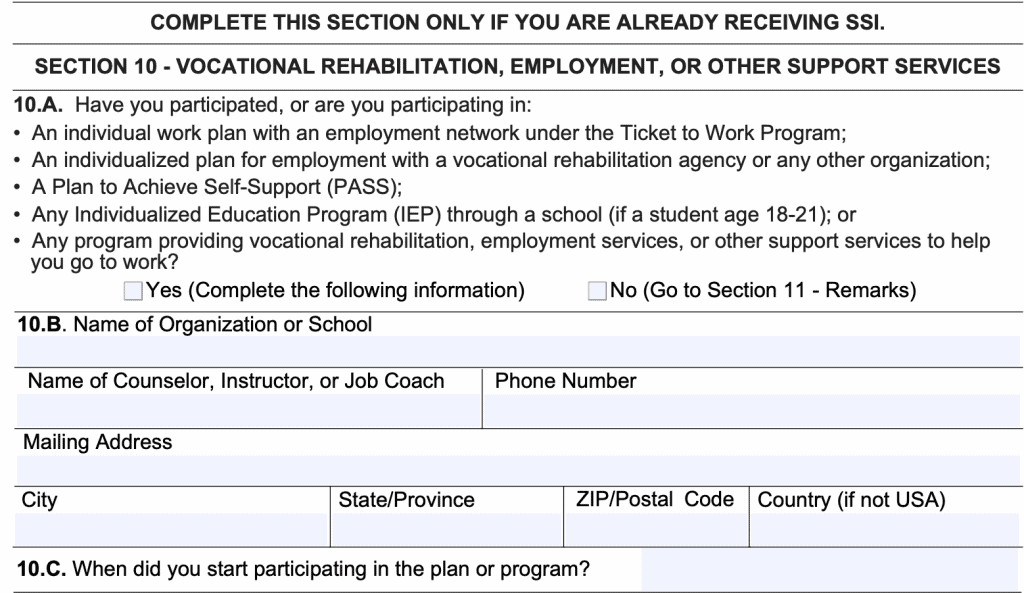
Section 11: Remarks
In the remarks section, you’ll simply add any information that wasn’t previously provided. Use this space to add remarks from sections where there was insufficient space.
At the end, you’ll date the report.
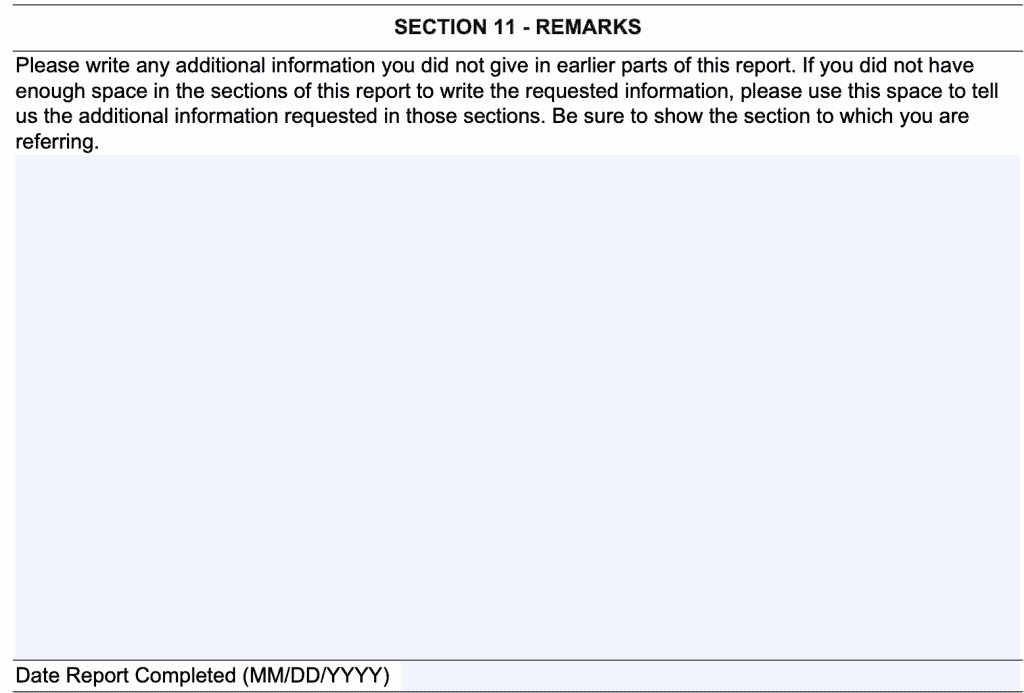
Why should I seek professional assistance?
Filing as a disability claimant can be a daunting task. It’s one thing to understand your medical conditions, as debilitating as they may be. But it’s another thing to present medical evidence that supports your disability claims to the satisfaction of the Social Security Administration.
There are two reasons why professional assistance might be of benefit to you.
Professionals can navigate the process.
A good disability attorney or Social Security advocate has experience helping people in your condition. Disability attorneys are familiar with laws such as the Social Security Act. However, they also understand how to navigate the bureaucracy to ensure that the SSA properly records and pays your disability claim.
Just as importantly, they don’t get paid unless you actually receive disability benefits. So you can rest assured that if the disability attorney takes your case, you’re sitting on the same side of the table.
And if multiple offices refuse to take your case, then it might save you a lot of time in filing a disability claim.
There are rules so that you don’t get taken advantage of.
Not just anyone can help disability claimants file their claims for compensation. The SSA has rules in place to help protect Social Security claimants from scam artists.
Below is some background on these rules.
The SSA must approve either a fee agreement or fee petition from your representative
Anyone who is representing a Social Security claimant for a fee must have their fee agreement approved by the Social Security Administration. If the fee agreement is approved by the SSA before a favorable decision is awarded, then the stated fee is the most that your representative can receive.
If the SSA does not approve the fee agreement before the decision, then the representative must file a fee petition.
There is a limit on the compensation that your representative can charge
Your fee agreement cannot exceed a certain limit, as specified by the federal government. That limit is the lesser of:
- 25% of past due benefits, OR
- $6,000
In other words, it should never cost more than $6,000 to have your Social Security disability claim approved. The best part is that you don’t write a check.
You don’t pay out of pocket.
All fees for representing a claim are made by either the federal government or a qualified 3rd party. In other words, your representative only gets paid:
- When there’s a favorable outcome, AND
- By someone else
But if you cannot find someone to help you, we’ll go over SSA Form 3368 so you can complete it on your own. But first, make sure you download the right version of the form.
Video walkthrough
Watch this instructional video to learn how to complete Form SSA-3368-BK, step by step.
Frequently asked questions
While you should have a professional review your claim to ensure accuracy and that you’ve included the appropriate documentation, you may also schedule an in-person visit with your local Social Security office.
Where can I find Form SSA-3368-BK?
You may find this form on the SSA website. For your convenience, we’ve attached the most current version to this article, below.
